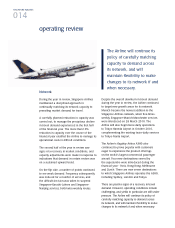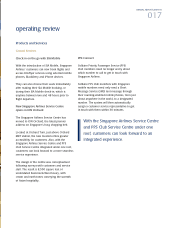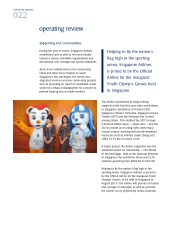Singapore Airlines 2010 Annual Report Download - page 23
Download and view the complete annual report
Please find page 23 of the 2010 Singapore Airlines annual report below. You can navigate through the pages in the report by either clicking on the pages listed below, or by using the keyword search tool below to find specific information within the annual report.
ANNUAL REPORT 2009/10
021
operating review
Environment
The aviation industry is facing the imminent
implementation of the EU Emission Trading
System (EU ETS), which will be effective
from 2012. Some countries are also actively
engaging in legislative processes to set up
domestic ETSs. Other emerging economic
measures such as environmental taxes and
levies are also being considered.
To avoid this patchwork of conflicting
economic measures that will have an adverse
impact on airlines, the International Air
Transport Association (IATA) is advocating
a global sectoral approach to ensure a level
playing field.
Singapore Airlines supports IATA’s approach
and its commitment for the industry to improve
fuel efficiency collectively by 1.5% annually
until 2020, to achieve carbon neutral growth
from 2020 and to achieve a 50% net reduction
in carbon emissions by 2050 compared to
2005 levels.
During the year in review, the Airline actively
participated in several green projects. In February
2010, Singapore Airlines carried out the first
multi-sector demonstration green flight under the
Asia and Pacific Initiative to Reduce Emissions
(ASPIRE) programme. The Airline employed a
series of efficiency measures for all phases of the
flight, and collaborated with aviation authorities
in Singapore, Japan and the US to ensure
optimum air traffic conditions. As a result, SQ 11,
which operated from Los Angeles to Singapore
via Tokyo, used approximately 6% less fuel than
normally required for a similar flight. The 10,686
kg of fuel saved resulted in carbon emission
savings of 33,769 kg.
Singapore Airlines also collaborated with Airbus,
BAA and National Air Traffic Services to launch
an improved departure procedure for Airbus
A380 operations at London Heathrow Airport.
A380s now use less power when taking off,
saving fuel and reducing emissions, while
remaining within the airport’s strict noise limits.
This new procedure saves an additional 300kg
of fuel per flight (equating to almost 1 metric
tonne of carbon dioxide emissions on a flight
from Heathrow to Singapore) as well as reduces
NOx emissions. The successful implementation
of this new procedure is an example of how
airlines, airports and regulatory authorities
can work together to achieve tangible
environmental benefits.
Going forward, Singapore Airlines will
continue its efforts to reduce emissions and
keep an active watch on new technologies and
alternative fuels, which have great potential
to further reduce aviation’s carbon footprint.
Further details of the Airline’s environmental
efforts are available online at singaporeair.com.
Singapore Airlines supports IATA’s
goal for the industry to achieve
carbon neutral growth from 2020.
























